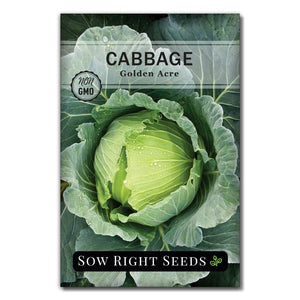Raised Beds vs. In-Ground Gardening: Which Method Grows the Best Garden?
Garden designAt Sow Right Seeds, we’ve spent years growing gardens using both raised beds and traditional in-ground rows. We know firsthand the benefits and challenges of each method and want to help you choose the best option for your space, soil, and gardening goals. Whether you're looking for neat, contained raised beds or the broad planting potential of row gardening, we’ll guide you through the pros and cons so you can make an informed decision and grow a thriving garden.

When you think of home gardening, what do you imagine? Do you think of a big sprawling in-ground garden with lots of rows, or do you think of raised beds? Which is the ideal gardening method?
You might not be surprised to learn that it depends a lot on your choice of garden location, soil quality, and other details. That’s why you'll consider the benefits and drawbacks and what is important for your personal success as a gardener. We've used different methods based on our location and what we were growing.

What is In-Ground Gardening?
In-ground gardening is a traditional method of growing plants directly in the soil without using raised beds or containers. It involves preparing the soil and planting directly into it, often in rows.
Some of us at Sow Right Seeds grew up with this type of gardening. We have early memories of daily chores that included at least one row of weeding the garden.
Gardening in rows is also common when growing large amounts of the same crop. Rows make it easy to water, fertilize, and harvest in a group.
Key Features of In-Ground Gardening:
- Uses the native soil in your yard, which may need improvement with compost or amendments.
- Ideal for large-scale gardens with plenty of space.
- Requires good soil drainage and weed management.
- More affordable than raised beds since it doesn’t require additional materials.
If you have enough space in your garden and good soil quality, you may prefer to plant in rows. Rows can be economical and easier to get started because they make use of the existing soil and don’t require a lot of setup. They can provide more room for crops that take up a lot of space, like pumpkins, squash, and corn.
Rows also allow gardeners to hoe around the roots and mound up soil for better water retention.

Rows are much easier to navigate if they are planted far apart with plenty of space in between, but there is a danger of the soil becoming compacted if it’s not maintained and kept loose.
Large corridors between rows are useful for those with machinery like tractors, plows, or harvesters, and they’re often used in large-scale agriculture for just this reason.
Rows are also easy to water through the use of furrows or placing sprinklers or other irrigation systems between rows.
In-ground gardens are not as permanent as beds and can be easily reverted to other uses in years you don’t want to grow a garden.

What are Raised Beds?
Raised bed gardening is a method where plants are grown in contained beds that sit above or on the ground. Usually framed with wood, metal, or other materials, these beds are filled with nutrient-rich soil, making them a great option for gardeners who want more control over their growing conditions.
Key Features of Raised Beds:
- Better soil quality – You can fill the bed with high-quality soil instead of relying on native soil.
- Improved drainage – Raised beds can prevent waterlogging and allow roots to thrive.
- Less weeding – Fewer weeds compared to in-ground gardens.
- Easier access – The raised height reduces bending and strain on your back.
- Ideal for small spaces – Great for urban gardens, patios, or areas with poor soil.
We've gardened in a variety of raised beds. Some were only a foot high and bordered with wood. Others are several feet high and made out of special metal. Raised beds can be an excellent solution for poor-quality soil or space considerations.
Constructing a raised bed can be costly, especially when you factor in any extra topsoil and amendments that need to be purchased.
Compact raised bed gardening allows you to grow a surprising amount of food in a small space and is more accessible to people with limited mobility.
Walking between raised beds will not compact the soil.

Raised beds do not retain moisture as well and may have increased water needs. It’s easier to manage weeds in a raised bed. Some crops are so large they may take up an entire bed and simply aren’t practical to be grown this way.
Alternative Methods
Although most discussion around garden beds is directly centered around raised bed gardening, it’s worth mentioning that beds can be grown directly in the ground, too. A block planting layout planted directly in the ground has some of the benefits and drawbacks of both raised bed and row gardening. An in-ground bed may be an efficient use of space for a small garden that’s more accessible and easier to maintain. An in-ground bed uses the existing soil, so consider that as well.

Raised Beds or Rows - Which Should You Choose?
Sometimes, the best answer is to experiment to decide what works best for you.
Depending on what you plant in your garden and what space you have available, you may decide to use a mixture of rows and beds. For example, you may have an herb garden planted in raised beds but decide that you prefer the ease of maintaining and harvesting your squash, beans, cucumbers, tomatoes, and melons when they are grown in rows or mounds.
A Three Sisters garden is a sort of hybrid design that might look more like rows or beds. Even though these three companion plants might be planted in rows of mounds or hills of the plants grouped together, the end result can look like a more densely packed bed.
There are so many types of gardens and gardeners. Too often, we get hung up on doing things the “right” way and finding a definitive answer for “which is best” -- even though what is perfect for one person’s situation might be completely wrong for another. Being adaptable and open to experimentation can often yield the best results.
Whether you decide to plant in-ground in rows, raised beds, or some combination of the two, be open and confident enough to change if something isn’t working. There’s no substitute for experience when it comes to finding out what works best for you in your gardening journey.
Resources:
Tips to Make More Efficient Use of Your Garden Space - South Dakota State University Extension
Raised Beds Versus Rows - Colorado State University Extension
Block Style Layout in Raised Bed Vegetable Gardens - Colorado State University Extension
Raised Beds vs. In-Ground Gardens - University of Georgia Extension
Starting a raised bed garden - MSU Extension
Raised Bed Gardening - OSU Extension
Written by Teresa Chandler
Popular Posts
-

Boost Your Garden's Charm with Native Coreopsis Flowers
-

How to Use Neem Oil on Plants for Successful Pest Control









Leave a comment